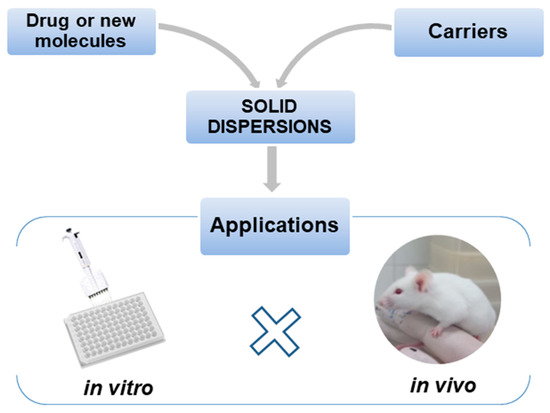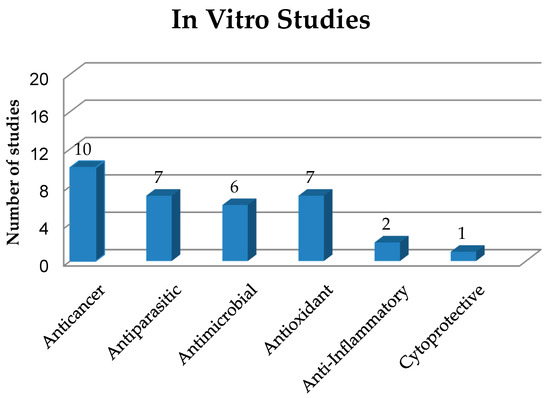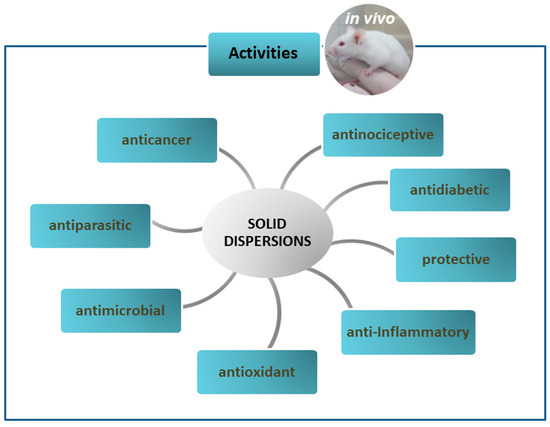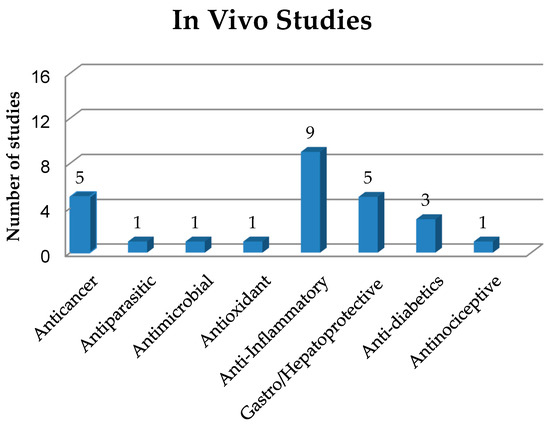Solid dispersions (SDs) are a technological strategy to improve the pharmacological potential of natural or synthetic bioactive molecules, due to the increase in its solubility and bioavailability, leading to a possible improvement of its biological activities.
In this sense, the review sought to synthesize and critically examine the studies that address SDs with therapeutic applications, evaluated through in vitro and/or in vivo tests.
This bibliographic survey shows the significant therapeutic potential of SDs in the context of the most diverse biological activities. Among these, including in vitro and/or in vivo antitumor, antiparasitic, antimicrobial, antioxidant, anti-inflammatory or cytoprotective activities, while additional activities, such as gastroprotective, hepatoprotective, antidiabetic or antinociceptive, were highlighted by in vivo studies.
Although SDs have already been studied and cited in the literature, the number of studies published with a focus on in vitro and in vivo trials is still relatively small, considering the great potential of these formulations in pharmaceutical technology and with the most diverse applications.
The results of biological activity studies showed that SDs, as a drug release tool, is not a limiting factor for the execution of in vitro and in vivo tests. Additionally, it stands out as a promising system in which the active principle and the carrier interact, allowing, in most cases, an increase in the pharmacological potential due to changes in the physicochemical properties of the constituents. Thus, SDs can represent a safe and effective alternative for the development and improvement of drugs directed to a wide range of pharmacological treatments.
- solid dispersions
- drug delivery
- biological applications
1. Introduction
Many drug candidates have low aqueous solubility, which can make their oral absorption inadequate. According to the literature, approximately 40% of marketed drugs are poorly soluble in water, as are, according to the Biopharmaceutical Classification System, about 40–90% of new drug candidates [ 1 , 2 , 3 , 4 ].
The slow dissolution rate and low solubility of some drugs lead to unpredictable bioavailability, non-reproducible clinical response or treatment inefficiency due to low therapeutic plasma levels; therefore, their use must be optimized using formulation strategies capable of improving their administration [ 5 ].
Several technological strategies have been developed and employed to circumvent this situation such as complexation with cyclodextrins, particle size reduction by micronization, crystal development, nanotechnology [ 5 ], salt formation and solid dispersions (SDs) [ 6 , 7 ]. However, some of these strategies have shown disadvantages including the development of active forms in vivo, high execution cost and considerable levels of toxicity. Some of these limits can be overcome by employing solid dispersions, a viable, well-established and widely-used strategy to increase the dissolution rate and solubility of poorly water-soluble drugs [ 4 , 6 , 7 ].
SDs can be defined as molecular mixtures of drugs that are not soluble in hydrophilic carriers, which exhibit a drug release profile driven by the polymer properties [ 8 ]. The so-called first-generation crystalline SDs, which use crystalline carriers such as urea and sugars including sucrose, dextrose and galactose, have the disadvantage of high thermodynamic stability that prevents a quick release of drugs [ 9 ]. In second-generation SDs drugs are dispersed in usually polymeric amorphous carriers [ 8 ], while the carriers used in third-generation SDs are surfactants or a mixture of amorphous polymers and surfactants [ 10 ].
The use of hydrophilic polymeric matrices to develop SDs for the release of commercial drugs or new drugs candidates has been shown to be a promising alternative able to improve their pharmacokinetic properties [ 7 ].
This review deals with SDs, mainly those belonging to the second-generation class that use polymers as carriers. It describes the main in vitro and in vivo activities (Figure 1) of SDs having different compositions and various preparation methods, intending to innovate and enhance the release of poorly water-soluble drugs, as well as improving the biological activities of the loaded bioactive compounds.

Figure 1. Representation of the application of solid dispersions in biological assays.
2. In Vitro Study of Solid Dispersions in Polymeric Matrices
This section deals with solid dispersions (SDs) prepared to improve the properties and release of poorly soluble drugs and drug candidates of natural or synthetic origin. The preparation and use of SDs have been reported in several in vitro studies, which have been numerically quantified and classified in Figure 2, based on the biological activities of their active compounds, while the main information on these studies is summarized in Table 1.

Figure 2. Quantification and classification of in vitro studies on solid dispersions published in the period from 2009 to 2020.
Table 1. In vitro studies on solid dispersions.
| Carrier Type | Substance | Cell Type | Activity | Improved Characteristics | Reference |
|---|---|---|---|---|---|
| OHPP | Niclosamide | PC-3, HeLa, A549 | Anticancer | SDs showed higher cytotoxicity to target cells (lower IC50) than the niclosamide solution. | [ 11 ] |
| OHPP | Paclitaxel | PC-3, HeLa, A549 | Anticancer | SDs showed significantly higher cytotoxicity to target cells (lower IC50) than the paclitaxel solution. |
[ 13 ] |
| PVP/VA TPGS |
Paclitaxel | BT-474, MCF-7, SK-BR-3 | Anticancer | SDs showed higher cytotoxicity against cancer cells compared to the pure drug. | [ 14 ] |
| Brij®L4 | Chrysin | HT29 | Anticancer | The higher solubility of chrysin in SDs compared to water solution increased cytotoxicity. |
[ 15 ] |
| Poloxamer 407 | Curcumin (CM) | NCIH460, HeLa, HepG2, MCF-7 and PLP2 |
Anticancer | Anticancer SDs showed cytotoxicity against all tumor cell lines tested, but no toxic effects on non-tumor cells. | [ 16 ] |
| AChE, BChE, GST, MAO A-B |
Enzyme inhibitory /Antioxidant |
SD was able to inhibit the activities of AChE, BChE and GST in aqueous medium. |
|||
| LPS-stimulated murine macrophages (RAW 264.7) |
Anti-inflammatory | IC50 (inhibitory concentration of 50% NO production by macrophages) > 400 µg/mL. | |||
| PVP K30 | Zn(II)-curcumin complex |
HepG2, SK-HEP1 | Anticancer | SD of Zn(II)-curcumin complex had a potent anticancer effect. | [ 17 ] |
| HPMC, PVP K30, PEG 6000 |
Telaprevir | HepG2 | Anticancer | The antitumor activity was dose dependent and even with the addition of the polymer the drug maintained its efficacy. | [ 18 ] |
| Soluplus ® | Angelica gigas Nakai | HeLa, HEK 293 | Anticancer | SD at the concentration of 200 µg/mL showed a significant decrease (to only 17.37%) in cell viability. There was no toxicity to normal cells. | [ 20 ] |
| Eudragit S-100 | Berberine hydrochloride (HB) |
SW480, HCT116, Caco-2 | Anticancer | The release of HB from SDs was effective and cell viability was reduced in a dose and time dependent manner. | [ 21 ] |
| PVP K30 | IIIM-290 | Ehrlich ascites carcinoma cells |
Cytotoxic | Despite the reduced amount of IIIM-290 in SD, the IC50 value of SD was lower than that of IIIM-290 alone. |
[ 24 ] |
| Poloxamer 407 | Benznidazole | Epimastigotes of Trypanosoma cruzi |
Antichagasic | SDs enhanced drug solubility, release kinetics and parasitic activity. | [ 25 ] |
| Low-substituted HPC | Benznidazole | Epimastigotes and intracellular amastigotes of T. cruzi (CL-B5) |
Antichagasic | SDs had higher antiparasitic activity against amastigotes than epimastigotes. | [ 28 ] |
| Gelucire 50/13 | Ursolic acid | Trypomastigotes of T. cruzi Y |
Antichagasic | Increased antiparasitic activity. | [ 29 ] |
| PVP K30,PVP/VA, Kollidon-CL-M, sodium starch glycolate |
Praziquantel | Adult schistosomes of Schistosoma mansoni |
Antischistosomal | Increased solubility, better bioavailability and stronger antiparasitic activity. |
[ 30 ] |
| PVP K30 | Praziquantel | Newly transformed schistosomula of S. mansoni and adults |
Antischistosomal | Increased solubility, reduced dosage especially for children and increased antiparasitic activity |
[ 31 ] |
| Soluplus, PEG 400, Lutrol F127 and Lutrol F68 |
Artemether | Schizonts of Plasmodium falciparum 3D7 |
Antimalarial | Increased dissolution rate, amorphous form, increased solubility and, mainly, increased antimalarial activity. |
[ 34 ] |
| Soluplus, Kollidon VA64, Plasdone S630 |
Lumefantrine | ITG cells | Antimalarial | Increased antiparasitic activity. | [ 35 ] |
| Chitosan | Abietic acid | Staphylococcus epidermidis | Antimicrobial | SD exhibited better MIC values against S. epidermidis than chitosan and abietic acid alone. |
[ 36 ] |
| DPPH radical scavenging | Antioxidant | SD had higher antioxidant power (IC50 of 0.61 mg/mL) than abietic acid alone (IC50 of 11 mg/mL). |
|||
| PVP K30 and HPMCAS | Griseofulvin | Dermatophytes of Trichophyton rubrum NCPF 935 |
Antimicrobial | SDs significantly reduced biofilm formation when compared to the control. |
[ 37 ] |
| Pluronic F127 | Gatifloxacin | Staphylococcus aureus | Antimicrobial | The gatifloxacin/Pluronic F127 system exhibited antimicrobial efficacy when compared to commercialized eye drops. |
[ 39 ] |
| PVP K30 | Curcumin | Salmonella enteritidis | Antimicrobial | SD had a strong antimicrobial effect on S. enteritidis, while CM alone did not show antimicrobial activity in vitro | [ 40 ] |
| HPMC | Curcumin | Escherichia coli | Antimicrobial | SD used to prepare phototoxic supersaturated solutions showed significant bactericidal activity against E. coli. | [ 41 ] |
| Polaxamer 407 | Curcumin | E. coli, Pseudomonas aeruginosa and S. aureus |
Antimicrobial | The association between SD and silver nanoparticles increased CM antimicrobial and antioxidant activities. |
[ 42 ] |
| DPPH radical scavenging | Antioxidant | ||||
| PVP K25 | Quercetin | DPPH radical scavenging | Antioxidant | Increased quercetin antioxidant activity in SD (0.61 ± 0.03 ≤ IC50 ≤ 1.00 ± 0.02 µg/mL). | [ 44 ] |
| Mannitol | Coenzyme Q10 | Intracellular ROS level | Antioxidant | The SD with the smallest particle size showed the greatest absorption of UVB radiation as well as the highest antioxidant activity in vitro. |
[ 45 ] |
| PVP K30 | Usnic acid | DPPH radical scavenging | Antioxidant | Increased usnic acid solubility and antioxidant activity. | [ 46 ] |
| PEG 4000 | Luteolin | DPPH | Antioxidant | Polymers increased luteolin solubility and antioxidant activity. | [ 47 ] |
| PVP K30, PEG 6000 and HPMC |
α,β-Amyrin | LPS-stimulated macrophages J774 |
Anti-inflammatory | SDs enhanced the anti-inflammatory activity of α,β-amyrin. | [ 7 ] |
| HPMC | Curcumin | HepG2 | Cytoprotective | SDs showed better cytoprotective activity than pure CM and inhibited cell death induced by t-BHP. | [ 48 ] |
OHPP, Octenylsuccinate hydroxypropyl phytoglycogen; IC50, Half inhibitory concentration; PVP/VA, Polyvinylpyrrolidone/vinyl acetate; TPGS, D-α-toco-pheryl polyethylene glycol-1000-succinate; PVP, Polyvinylpyrrolidone; SD, Solid dispersion; AChE, Acetylcholinesterase; BChE, Butyrylcholinesterase; CM, Curcumin; GST, Glutathione S-transferase; MAO, Monoamine oxidase; LPS, Lipopolysaccharide; NO, Nitric oxide; PEG, Polyethylene glycol; HPMC, Hydroxypropyl methylcellulose; ITG (chloroquine-resistant cell line); DPPH, 2,2-diphenyl-1-picryl-hydrazyl-hydrate; HPMCAS, Hydroxypropyl methylcellulose acetate succinate; MIC, Minimum inhibitory concentration; ROS, Reactive oxygen species; t-BHP, tert-Butylhydroperoxide.
3. In Vivo Studies of Solid Dispersions in Polymeric Matrices
As already mentioned, solid dispersions (SDs) have been used as a strategy in pharmaceutical technology to circumvent some limitations presented by drugs and new bioactive compounds such as low solubility and bioavailability. In this sense, this section addresses in vivo studies on SDs with different biological activities, as shown in Figura 3 and quantitatively expressed in Figure 4 . The main information about these studies is summarized in Table 2.

Figure 3. In vivo activities of solid dispersions.

Figure 4. Quantification and classification of in vivo studies on solid dispersions published in the period from 2009 to 2020.
Table 2. In vivo studies of solid dispersions.
| Carrier Type | Substance | Animal | Dose | Activity | Improved Characteristics | References |
|---|---|---|---|---|---|---|
| PVP K30 | IIIM-290 | Swiss male mice (18–23 g) |
25, 50 and 75 mg/kg | Anticancer | SD was able to reduce the IIIM-290 dose by at least 1.5-fold thanks to its efficiency in Ehrlich solid tumor model. | [ 24 ] |
| Soluplus® | 9-Nitrocamptothecin | Male Sprague-Dawley rats (20 ± 2 g) |
4 mg/kg | Anticancer | SD showed higher tumor growth inhibitory rate than the pure compound due to improved oral bioavailability. | [ 49 ] |
| (+)-Xylitol | (−)-Oleocanthal | Athymic nude mice | 10 mg/kg | Anticancer | Treatment with SD showed prevention, lower growth rate and less recurrence of tumor. | [ 50 ] |
| PVP K30 | Zinc(II)-curcumin complex |
B-NDG, BALB/c mice | 100 mg/kg | Anticancer | SD reduced tumor size and weight in animals. | [ 17 ] |
| PVP K30 | Selaginella doederleinii Hieron |
BALB/c mice | 200 mg/kg | Anticancer | SD reduced tumor size as well as the level of tumor angiogenesis. | [ 53 ] |
| Low substituted HPC | Benznidazole | Female NMRI mice (25 ± 2 g) |
25 mg/kg/day | Antichagasic | The best SD showed a 96.65% trypanocidal activity, expressed as percentage reduction in the area under the parasitic curve. | [ 28 ] |
| PVP K30 | Curcumin (CM) | Male Cobb-Vantress broiler chickens |
1 g/kg of feed | Antimicrobial | The synergistic effect of 0.05% CM/PVP SD with 0.05% boric acid reduced colonization of Salmonella enteritidis in crop and ceca-cecal tonsils. | [ 40 ] |
| PVP K30 | Taurine-zinc complex | Female Sprague-Dawley rats (240–260 g) |
100 and 200 mg/kg/day |
Antioxidant | SDs protected rat gastric mucosa from ethanol-induced injury and increased SOD activity and glutathione level. |
[ 58 ] |
| Gastroprotective | ||||||
| Kollidon (VA64) | Triacetylated andrographolide (TA) |
Male Kunming mice |
50, 100 and 200 mg/kg/day |
Anti-inflammatory | TA-SD prepared with VA64 significantly improved the drug activity against ulcerative colitis. | [ 59 ] |
| PVP K30, Poloxamer 188 | Curcumin | Female CD-1 mice | 100 mg/kg oral doses | Anti-inflammatory | CM-SD prepared with PVP decreased matrix metallo-peptidase 9 expression and levels of IL-1β and IL-6 cytokines. | [ 60 ] |
| Gelucire®50/13-Aerosil® | Curcumin | Rat | 10 to 100 mg/kg | Anti-inflammatory | A CM-SD dose of 100 mg/kg was more effective than 5 mg/kg indomethacin in reducing edema | [ 61 ] |
| HPMC, lecithin and isomalt |
Curcumin | Male Sprague-Dawley rats |
5 mg/kg | Anti-inflammatory | A CM-SD dose of 5 mg/kg had greater anti-inflammatory activity than 50 mg/kg curcumin alone. | [ 62 ] |
| Crospovidone | Aceclofenac | Male Sprague-Dawley rats |
1 g/cm2 (topical) |
Anti-inflammatory | The enhanced drug permeation increased the intensity of the anti-inflammatory response. | [ 65 ] |
| PEG 8000 | Ibuprofen | Wistar rats | 20 mg/kg | Anti-inflammatory | All SDs showed better anti-inflammatory activity than the pure drug, allowing up to 90% edema inhibition after 6 h. | [ 66 ] |
| Urea and mannitol | Flurbiprofen | Rat | 11.69 mg/kg | Anti-inflammatory | SD showed better inhibition of rat paw edema up to 16 h. | [ 67 ] |
| Paracetamol | Meloxicam | Rat | - | Anti-inflammatory | SDs reduced by more than 50% the volume of carrageenan-induced tail edema compared to the physical mixture. | [ 68 ] |
| PVP K30 | Chelerythrine (CHE) | Mice | 10 mg/kg | Anti-inflammatory | SD enhanced CHE anti-inflammatory effect by reducing the levels of TNF-α, IL-6 and NO in mice serum. | [ 69 ] |
| HPMC | Curcumin | Male BABL/c mice | 200 and 400 mg/kg | Hepatoprotective | The best SD increased the hepatoprotective efficacy of CM. |
[ 48 ] |
| HPC | Nobiletin | Male Sprague-Dawley rats (220 g) | 2 mg of drug/kg | Hepatoprotective | SD was more effective than the crystalline drug in rats with acute liver injury | [ 70 ] |
| PVP K30 | Silymarin | Adult male albino rats (150–200 g) | 25 mg/kg | Hepatoprotective | The best SD improved biomarker rates and had a significantly better hepatoprotective effect than the commercial extract | [ 71 ] |
| PVP K30 | Silymarin | Male Sprague-Dawley rats (190–210 g) | 50 mg/kg | Hepatoprotective | SD improved drug solubility and hepatoprotective activity, reducing the AST levels. | [ 72 ] |
| Poloxamer 188 | Repaglinide | Wistar rats (150–250 g) ) |
(1 mg of drug) | Antihyperglycemic | SD obtained by the microwave method improved the drug anti-hyperglycemic activity. | [ 74 ] |
| Soluplus1 and PEG 4000 | Glimepiride | Albino Wistar rats (200–250 g) |
0.0285 mg of drug/kg | Anti-diabetic | SD reduced the glucose level in rats more than the pure drug and a commercial product | [ 5 ] |
| PVP K17 | Pioglitazone | Male Swiss albino mice (25–30 g) | 30 mg/kg SD | Antihyperglycemic | SD reduced the mean glucose level in mice more than the pure drug and a commercial product. | [ 76 ] |
| HPMC | Hecogenin acetate | Male Swiss mice (28–35 g) |
40 mg/kg | Antinociceptive | Both the drug alone and its SD with HPMC-reduced mechanical and thermal hyperalgesia induced by crushing of the sciatic nerve in mice. | [ 77 ] |
PVP, Polyvinylpyrrolidone; SD, Solid dispersion; HPC, Hydroxypropyl cellulose; CM, Curcumin; CM/PVP SD, curcumin/polyvinylpyrrolidone solid dispersion; SOD, Superoxide dismutase; PEG, Polyethylene glycol; TNF-α, tumor necrosis factor alpha; IL, interleukin; NO, Nitric oxide; HPMC, Hydroxypropyl methylcellulose; AST, Aspartate aminotransferase.
4. Conclusions
Solid dispersions are a technological strategy to improve the pharmacological potential of natural or synthetic bioactive molecules, thanks to an increase in their solubility and bioavailability, thus leading to possible enhancement of their biological activities. In this context, this review sought to summarize and critically examine studies conducted with this approach both in vitro and in vivo, which have provided evidence of a significant therapeutic potential that solid dispersions could offer in the context of the most diverse biological activities.
As poorly water-soluble active ingredients incorporated in solid dispersions exhibited improved physicochemical and pharmacological properties, these systems can be targeted in the pharmaceutical industry as possible therapeutic alternatives for certain diseases, with greater selectivity, safety and efficacy than the existing treatments.
This entry is adapted from the peer-reviewed paper 10.3390/pharmaceutics12100933
